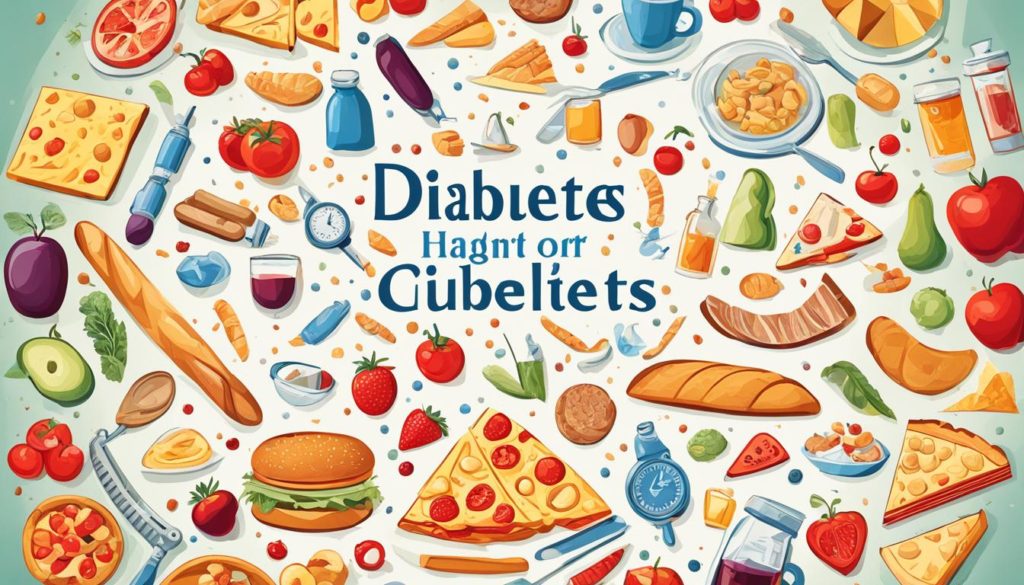Over 37 million Americans live with diabetes. Almost all, about 90-95%, have type 2 diabetes. It’s crucial to understand what causes it and how it starts.
Type 2 diabetes means the body can’t handle glucose well, causing high blood sugar. This happens when there’s not enough insulin or cells ignore it. Insufficient insulin or resistance to it can lead to serious health issues.
Getting type 2 diabetes depends on several factors. Obesity, a family history of diabetes, and lack of physical activity are key factors. High blood sugar, or prediabetes, also is a warning sign for type 2 diabetes.
To lower these risks, it’s important to eat healthily and stay active. Keeping an eye on blood sugar and following your doctor’s advice can help too. This can prevent type 2 diabetes from getting worse.
Key Takeaways
- Type 2 diabetes affects approximately 90-95% of the 37 million Americans diagnosed with diabetes.
- The condition results from the pancreas not producing enough insulin or cells not responding effectively to insulin.
- Obesity, family history, and physical inactivity are significant diabetes type 2 triggers.
- Prediabetes is an important early indicator that can progress to type 2 diabetes if untreated.
- Lifestyle modifications, including a healthy diet and regular exercise, are essential in managing type 2 diabetes.
What is Type 2 Diabetes?
Type 2 diabetes is a long-term illness that changes how your body handles glucose, causing high blood sugar. It happens when the body either makes too little insulin or can’t use it right.

Definition and Overview
Type 2 diabetes means your body doesn’t make enough insulin, or your cells ignore it. This makes your blood sugar go up, which can harm your health over time. It’s different from type 1 diabetes, where your body can’t make insulin at all. Type 2 usually starts in adults, but more kids are getting it now because of obesity.
How is it different from Type 1 Diabetes?
Finding out if it’s type 2 diabetes or type 1 is very important. Type 1 diabetes happens when your immune system attacks cells in your pancreas, stopping insulin production completely. But in type 2, your body still makes insulin; it just doesn’t work well. Risk factors for type 2 include your genes, how you live, and things around you. Comparing them helps us know more and fight their effects better.
| Factor | Type 1 Diabetes | Type 2 Diabetes |
|---|---|---|
| Insulin Production | None | Reduced or Ineffective Use |
| Age of Onset | Childhood | Adulthood (Recently increasing in children) |
| Key Risk Factors | Autoimmune, Genetic | Lifestyle, Genetic |
Knowing the differences helps doctors identify type 2 diabetes from type 1. This ensures patients get the right care and treatments.
Common Symptoms of Type 2 Diabetes

Understanding symptoms of type 2 diabetes is key for timely help. Spotting these signs early means people can get advice before things get worse.
Early Warning Signs
The early signs of type 2 diabetes are not always clear and come on slowly. It’s crucial to notice these early symptoms:
- Increased thirst and frequent urination
- Unintended weight loss
- Fatigue and lack of energy
Advanced Symptoms
If type 2 diabetes isn’t treated, symptoms can get worse. More serious health issues can happen, like:
- Blurred vision
- Slow healing of sores and more infections
- Numbness or tingling in feet or hands
- Dark skin patches in places like the neck or armpits
Spotting type 2 diabetes signs early and late can really improve life. It also cuts down on health problems.
Key Type 2 Diabetes Causes and Risks
Understanding what leads to type 2 diabetes is vital. One main cause is genetic predisposition. If diabetes runs in your family, your risk of getting it goes up.
Being overweight, especially carrying extra weight around your belly, is another big risk factor. This kind of fat can cause inflammation and make your body resist insulin. Not being active makes things worse by increasing weight and lowering insulin sensitivity.
Some groups of people have a higher risk. African Americans, Hispanics, Native Americans, and Asian Americans are more likely to get type 2 diabetes because of their genes and lifestyle choices. Also, getting older puts you at higher risk, especially if you’re over 45.
High blood pressure and high cholesterol also play a role. They put stress on your heart and make it hard for your body to manage sugar levels.
Factors linked to pregnancy, like gestational diabetes, raise the risk too. Polycystic ovary syndrome (PCOS) can also make your body resist insulin, posing a risk mainly to women.
At its core, type 2 diabetes happens when there’s a problem with insulin in your body. Your pancreas may not make enough insulin, or your body might not use it rightly. This makes blood sugar levels spike.
| Risk Factor | Description |
|---|---|
| Genetic Predisposition | Family history increases likelihood |
| Abdominal Fat | Higher inflammation and insulin resistance |
| Sedentary Lifestyle | Reduced physical activity lowers insulin sensitivity |
| Demographics | Higher risk in African Americans, Hispanics, Native Americans, Asian Americans |
| Age | Increased risk above 45 years |
| High Blood Pressure | Strains cardiovascular system, impairs glucose metabolism |
| Gestational Diabetes | Significant risk post-pregnancy |
| PCOS | Affects insulin resistance in women |
Role of Insulin and Glucose
Understanding how insulin and glucose work together is key for handling Type 2 diabetes well. We’ll look at how insulin functions and why it’s important to keep glucose levels in check.
How Insulin Works
Insulin is an important hormone made by the pancreas. It lets glucose from food go into cells, changing it into energy. This energy is needed for different body activities. The role of insulin in diabetes cannot be overstated.
When insulin works right, it helps glucose get used by the cells properly. But with Type 2 diabetes, cells resist insulin. This messes up the normal way insulin and glucose work together, making blood glucose levels rise.
Importance of Glucose Regulation
Managing glucose well in diabetes is crucial to dodge the bad effects of high sugar levels. Glucose is what cells use for fuel. It comes from foods we eat and also the liver. In Type 2 diabetes, controlling glucose gets harder because the body doesn’t use insulin right.
This can lead to very high blood sugar. Over time, this can harm the cells that make insulin, making diabetes worse and leading to other serious health issues.
Keeping insulin and glucose in harmony is vital for good health and managing Type 2 diabetes. Ways to keep this balance include changing your lifestyle, eating better, and sometimes taking meds.
Genetic Factors and Family History
Genetics play a big role in type 2 diabetes. Those with diabetic family members are at more risk. This shows how important genes are in getting this disease.
Inheritance Patterns
Type 2 diabetes can run in families. If your parents or brothers and sisters have it, your risk goes up. This is because of shared genes and lifestyles that make diabetes more likely.
Genes Linked to Type 2 Diabetes
Scientists have found specific genes that make people more likely to get diabetes. Key ones include TCF7L2, PPARG, and KCNJ11. These genes affect insulin use and blood sugar control. Knowing about these genes helps doctors predict who might get diabetes and plan treatments.
| Gene | Function | Impact |
|---|---|---|
| TCF7L2 | Regulates blood sugar | Increases risk of high blood glucose |
| PPARG | Insulin sensitivity regulation | Associated with insulin resistance |
| KCNJ11 | Regulates insulin secretion | Linked to improper insulin release |
Lifestyle and Dietary Factors
It’s key to know how our lifestyles can affect type 2 diabetes. Different habits and what we eat matter a lot. They help in both avoiding and handling this condition.
Impact of Diet on Diabetes Risk
The link between diet and type 2 diabetes is clear. Eating too much red meat, sweets, and fried foods is bad. It can make us gain weight and reduce our body’s ability to use insulin. Eating better, like choosing lean meats, veggies, good fats, and whole grains, is key.
Importance of Physical Activity
Staying active is crucial for preventing diabetes. When we move more, it helps balance our blood sugar. It also keeps our weight in check and makes our body respond better to insulin. Just taking quick walks regularly can make a big difference.
To really lower diabetes risk, eat well and stay active. Doing both is very effective against type 2 diabetes.
| Factor | Impact on Type 2 Diabetes | Recommended Changes |
|---|---|---|
| Diet | High intake of red meat, sweets, fried foods | Increase lean proteins, veggies, healthy fats |
| Physical Activity | Insufficient exercise | Engage in regular physical activities |
The influence of lifestyle on type 2 diabetes is huge. Choosing better foods and being active are vital steps.
Understanding Prediabetes
Prediabetes is when your blood sugar is higher than it should be but not high enough for a diabetes diagnosis. It’s a warning sign. Without action, it can lead to Type 2 diabetes.
What is Prediabetes?
Prediabetes means your blood sugar is between normal and high. Your body might not use insulin well or make enough of it. Knowing about it early is key to stopping diabetes.
How to Prevent Progression to Type 2 Diabetes
To stop prediabetes from becoming diabetes, changes in lifestyle and medicine can help. Here’s what works:
- Dietary Changes: Eat foods that are whole and not processed. Focus on whole grains, lean proteins, and healthy fats. Cut down on sugars and junk food.
- Physical Activity: Activities like brisk walking or biking make your body use insulin better and lower your blood sugar.
- Medical Interventions: Drugs like metformin might be used to control your blood sugar levels.
- Regular Check-ups: Watching your blood sugar regularly helps tweak your treatment plan when needed.
Here’s a quick look at some lifestyle tweaks for prediabetes:
| Healthy Habit | Impact on Prediabetes |
|---|---|
| Balanced Diet | Better blood sugar and overall health. |
| Regular Exercise | Improves how your body uses insulin and lowers blood sugar. |
| Weight Management | Reduces your chance of getting Type 2 diabetes. |
| Regular Monitoring | Keeps you informed about your blood sugar levels. |
Health Risks Associated with Type 2 Diabetes
When Type 2 diabetes isn’t managed, it can cause serious health issues. It’s vital to manage it through healthy living and medical help.
Complications of Uncontrolled Diabetes
Not handling Type 2 diabetes well can lead to problems. These include heart disease, neuropathy, and kidney disease. Heart disease is a top cause of serious health problems due to damaged blood vessels from high sugar.
Neuropathy means nerve damage. This can cause anything from mild tingles to severe pain. Kidney disease is also a risk since kidneys strain to filter extra sugar, which might lead to failure.
Vision can also be impacted, with severe cases leading to blindness from diabetic retinopathy. Taking good care of your diabetes can prevent many such issues. It shows why it’s crucial to follow health care advice closely.
Long-term Health Implications
Diabetes has long-term impacts. It can affect how well your brain works and lower life quality. Research links Type 2 diabetes to cognitive declines, such as dementia.
Diabetes also causes slow-healing wounds and more infections. This makes daily health care more complex.
Dealing with diabetes’s long-term effects is key to living well. Keeping complications away requires a healthy diet, exercise, and doctor visits. For tips on managing diabetes well, check out this resource.
Prevention and Management Strategies
Preventing and managing type 2 diabetes involves several keys steps. It’s about lifestyle changes, keeping an eye on health stats, and sometimes, medical help. This approach makes sure sugar levels stay right. It cuts down complication risks.
Diet and Exercise Recommendations
A healthy diet and staying active are super important for handling diabetes. Key diet tips include:
- Incorporating high-fiber foods like vegetables and whole grains.
- Limiting sugar and refined carbohydrate intake.
- Choosing lean proteins and healthy fats.
Moving your body, through walking or biking, makes your body use insulin better. This helps manage sugar levels. Try to get in 150 minutes of exercise like this every week.
Medications and Insulin Therapy
Medication is a big part of controlling diabetes. Some common ones are:
- Metformin: Lowers sugar made by your liver.
- GLP-1 Agonists: Boosts insulin after you eat.
- Insulin Injections: Important for extra sugar control.
| Medication | Function | Notes |
|---|---|---|
| Metformin | Reduces liver glucose production | Often first-line therapy for type 2 diabetes |
| GLP-1 Agonists | Enhances post-meal insulin release | May aid weight loss as well |
| Insulin Injections | Provides supplemental insulin | Essential for some individuals requiring tight glucose control |
To best prevent and manage diabetes, following your doctor’s medication advice is key. Think about insulin therapy if your doctor suggests it. Using tools like CGM helps track your sugar levels. This makes adjusting treatments easier.
Conclusion
Type 2 diabetes comes from a mix of genetics, how we live, and our environment. We have looked closely at the disease, its symptoms, and how it’s different from type 1 diabetes. We also talked about how insulin and glucose work. These facts highlight the need to understand the disease to fight it well.
It’s key to know that we can fight the impact of type 2 diabetes by being proactive. Family history and certain genes make some people more likely to get it. Still, eating well and staying active can lower your risk. Spotting prediabetes early and dealing with it can stop it from becoming worse.
To manage type 2 diabetes well, you need a total plan. This plan should include the right food, exercise, medicine, and sometimes insulin. Teaching people more about the disease helps them make smart choices. By focusing on these parts, we aim to lessen type 2 diabetes and help those living with it enjoy better lives.
FAQ
What is Type 2 Diabetes?
Type 2 diabetes means having high sugar levels in the blood. It happens because of insulin issues. The body doesn’t make enough insulin or can’t use it well. This leads to high blood sugar.
How is Type 2 Diabetes different from Type 1 Diabetes?
Type 1 diabetes is when the body makes no insulin because of an autoimmune disorder. Type 2 is different because the body makes insulin but not enough or it doesn’t work well. Type 1 usually starts in childhood, but Type 2 can start in adults or kids, often due to obesity.
What are the common symptoms of Type 2 Diabetes?
People with Type 2 diabetes often feel very thirsty and pee a lot. They may lose weight without trying and feel tired. They might have blurry sight, sores that heal slowly, get infections often, or feel numbness. Their skin can also get dark in places.
What are the primary causes and risk factors for Type 2 Diabetes?
Type 2 diabetes can happen because of genes, being overweight, or not moving much. Having high blood pressure or being older can also play a role. Some races and ethnic groups have a higher risk too.
How do insulin and glucose interact in the body?
Insulin helps glucose, or sugar, go from your blood into your cells for energy. In Type 2 diabetes, this process doesn’t work right. So, sugar builds up in the blood, which can harm cells that make insulin.
How significant is heredity in developing Type 2 Diabetes?
If your family has a history of Type 2 diabetes, your risk goes up. Genetics is a big factor in whether you’ll get it. This shows that family history is important.
What lifestyle and dietary factors affect the risk of developing Type 2 Diabetes?
Eating too much red meat, sweets, fried foods, and simple carbs can be bad. They can make you gain weight and lead to insulin problems. Doing exercises and eating healthy helps a lot. Focus on lean proteins, veggies, healthy fats, and complex carbs.
What is Prediabetes, and how can it be managed?
Prediabetes means your blood sugar is high but not high enough for a diabetes diagnosis. It can turn into Type 2 diabetes if not handled. To manage it, change your diet, move your body more, and you might need medicine like metformin.
What are the health risks associated with uncontrolled Type 2 Diabetes?
Not managing Type 2 diabetes can cause big health problems. It can hurt your heart, blood vessels, nerves, and eyes, leading to heart disease, nerve damage, and kidney issues. Vision could get worse, and wounds don’t heal well.
What are effective prevention and management strategies for Type 2 Diabetes?
To prevent or manage Type 2 diabetes, eat healthily and stay active. Check your blood sugar often. You might need medicine or insulin shots. Keeping an eye on your sugar levels and living a healthy lifestyle are key.


